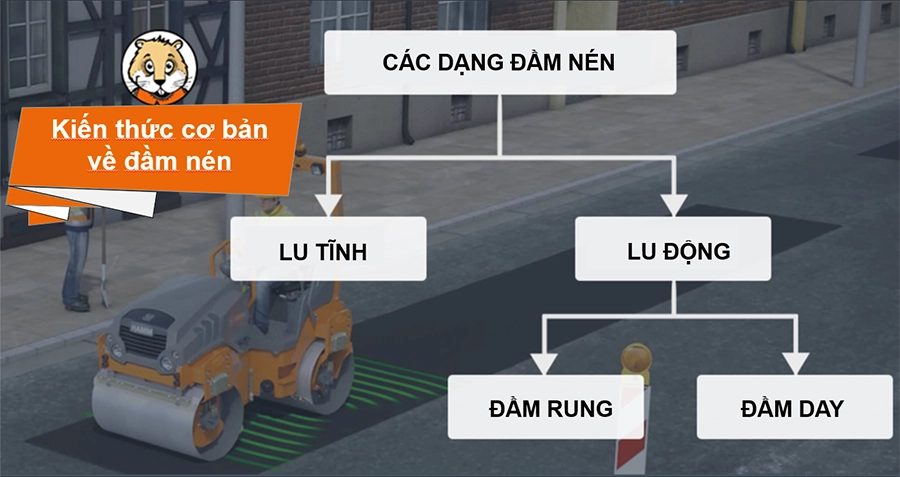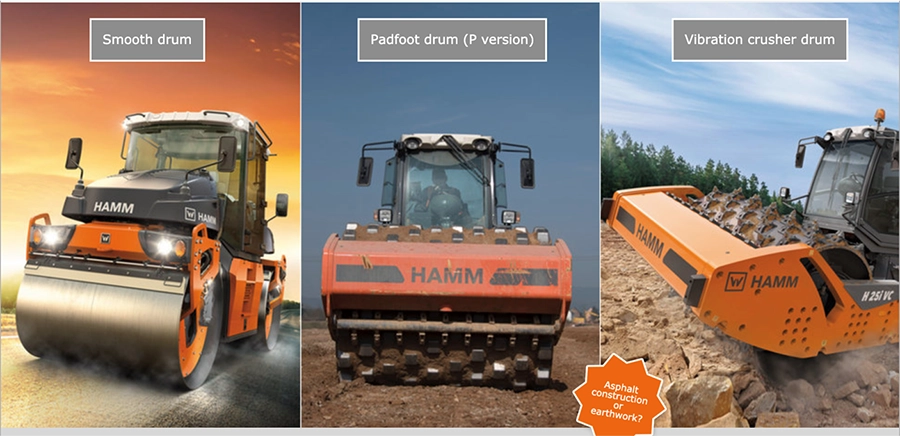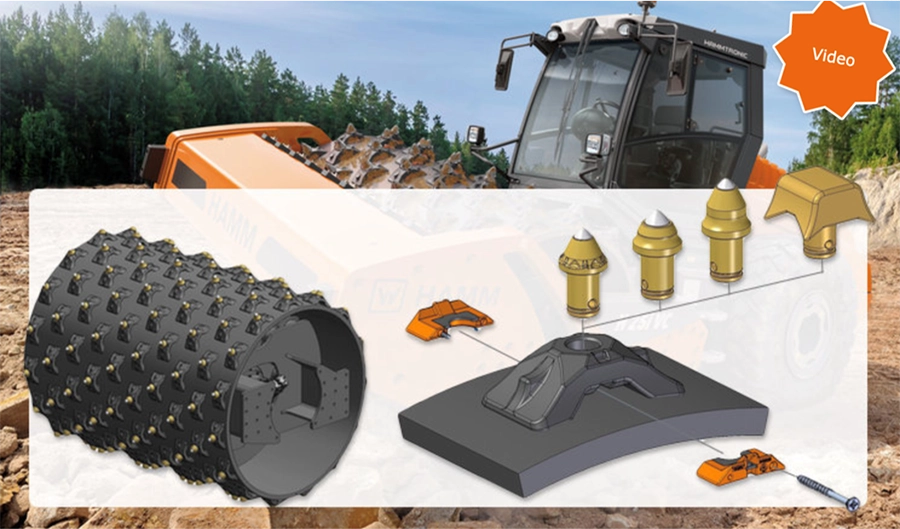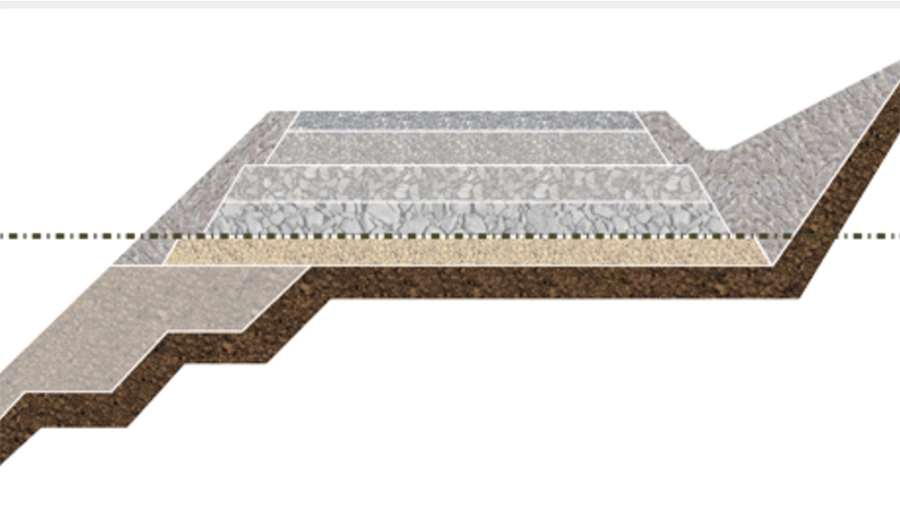BASIC KNOWLEDGE OF COMPACTION
One of the prerequisites to ensure that tall buildings, towers, airports and other structures last for a long time is a solid, compacted ground or road structure. This is considered as one of the prerequisite and mandatory processes. The following article shares the basic knowledge about the compaction process.
VIDEO SHARING BASIC KNOWLEDGE ABOUT COMPACTION
OVERVIEW OF COMPACTION

1. What are the main objectives of compaction?
+ High load-bearing capacity: Increased friction (contact ratio) in the material.
+ Good stability: Reduction of void content (low water permeability).
+ Long service life of the building structure
2. What compaction systems are there?

a. What is static compaction?

Compaction is controlled by the pressure that the net weight of the machine applies to the subsoil. The pressure achieves a higher deposit density. This reduces the void content and increases stability. Compaction occurs from the top down.
The static linear load is calculated in order to compare the compaction performance of different machines. The following measurements are considered for this:
- Axle load ( drum side)
- Drum width
Calculating the static linear load:
The quotient of two dimensions provides information about the static compaction performance of the roller. The higher the static linear load, the greater the static compaction performance of the roller.

| Roller type | Static linear load |
| Small tandem rollers 1.5 - 4 t (3 300 - 8 800 lbs) | 8 - 15 kg/cm (53.5 – 88.3 lbs/") |
| Heavy tandem rollers 7 - 14 t (15 400 - 30 900 lbs) | 25 - 30 kg/cm (133.1 – 164.7 lbs/") |
| Compactors 5 - 25 t (11,000-55,100 lbs) | 20 - 70 kg/cm (107 – 437.5 lbs/") |
| Pneumatic tyre rollers | 9 000 - 3 750 kg/wheel (2 349 – 7 663 "/tyre) |
b. What is dynamic compaction?

During dynamic compaction, higher forces than in purely static compaction (vibration: centrifugal forces; oscillation: shear forces) are directed onto the material to be compacted. The material is also made to vibrate during dynamic compaction. This reduces the friction within the material and therefore supports compaction. The compaction is carried out from the bottom to the top. The material is settled by the vibrations.
During dynamic compaction, the unbalance masses make the drum vibrate. These vibrations are transmitted to the individual grains in the material to be compacted. This reduces the friction between the grains and facilitates grain redistribution.
What factors have a decisive influence on dynamic compaction?
- Amplitude
- Frequency
- Rolling speed
Video: Ground coffee (dynamic)
c. Effect of the unbalance mass
Depending on the direction of rotation of the exciter shaft, the loose unbalance moves to one side or the other (centrifugal force). This changes the acting unbalance mass as well as the amplitude.
- Unbalance masses: The unbalance masses are located on a shaft in the drum.

- Amplitude: The degree to which the vibrating drums move up and down.

- Vibration displacement: The distance that the vibrating drum depicts up and down (i.e. 2 x distance of the amplitude)

- Frequency: The frequency measured in hertz (vibrations per minute - vpm), describes the number of revolutions per second of the unbalance mass. The frequency influences the frequency of the compaction impacts.

- Large amplitue - Greater depth effect.
- Small amplitue - Lesser depth effect.

The corresponding frequencies must be selected according to the specified amplitude. As a rule of thumb:
- Large amplitude - low frequency
- Small amplitude - high frequency
Depending on the type of tandem roller, the amplitude or frequency for both drums can be adjusted synchronously (dependent on one other) or individually (independently of one other). As a result, there are two vibration parameters:
- Synchronous front/rear: amplitude and frequency cannot be adjusted independently.
- Individual front/rear: amplitude and frequency can be adjusted independently.
What is the role of the speed?

Along with the frequency, the speed influences the frequency of the compaction impacts (stroke distance) per distance unit. Typical roller speeds are:
- Earthwork: approx. 2 - 3 km/h (1.2 - 1.9 mph)
- Asphalt construction: approx. 4 - 5 km/h (2.5 - 3.1 mph).
Frequency and speed must be well matched for optimal compaction performance.

+ Impact distances too low: If the impact distances are too low it can lead to grain fragmentation.
+ Impact distances too high: If the impact distances are too high the compaction performance decreases and it can lead to wave formation.
- Optimally coordinated speed and frequency:

Optimally coordinated roller speed and frequency are a prerequisite for efficient, high-quality compaction. The surface to be compacted will in this case have the desired density after a few passes.
For the United States in particular, where asphalt is layed at high speed, there are special roller types (-HV or -HF). These rollers can compact at a significantly higher frequency in order to achieve optimal compaction results at higher speeds too.
3. What drum types are there?

a. Smooth drum
The smooth drum comes in two versions:
- The non-split drum is worked continuously and is driven by a drive motor.

- The split drum (only for asphalt rollers) consists of two equal halves, each of which is driven by a drive motor. Split drums are particularly suitable for compacting winding roads or asphalt surfaces that are prone to distortion.
Video: Split drum: Different speeds of the inner + outer half of the drum when cornering

Large drum diameters reduce the shifting of the material (blisters) with the same machine weight.
What is the significance of the Nijboer number?
The Nijboer number indicates the tendency of an asphalt roller to form bulges (slide) in front of the drums and cracking behind the drums. The N ratio during dynamic compaction should not be greater than 0.25 kg/cm² (3.56 lbs/in²).
N = Static linear load (kg/cm) / Drum diameter (cm)
| Type | NIJBOER Number (N) |
| Light tandem rollers 1.5 - 4 t (3,300 - 8,800 lbs) | 0.15 - 0.17 kg/cm² (2.13 – 2.42 lbs/in²) |
| Heavy-duty tandem rollers 7 - 13 t (15,400 - 28,700 lbs) | 0.20 - 0.24 kg/cm² (2.84 – 3.41 lbs/in²) |
b. Padfoot roller drum
The drum consists of a smooth roller with additional welded 8 - 10 cm (3.1 - 3.9") high, trapezoidal studs. The padfoot drum is not suitable for breaking stone.

Areas of application: Earthwork, Cold recycling, Kneading and roughening soil, Increasing the surface area for faster drying of the surface.
C. Vibration crusher drum

The drum consists of a smooth roller with an additional welded quick-change tool holder system for the various tools for breaking stone. The option of using different cutting tools and padfoot insets make the machine a versatile device.
4. Where are pneumatic tyre rollers mainly used?

Four rubber wheels (untreaded tyres) are each attached to an axle at a slight distance. Pneumatic tyre rollers compact statically through the net weight of the machine. The compaction effect and depth depends on the wheel load, tyre pressure and roller speed.
Wheel load describes the weight of the machine per wheel e.g. 24 t (52,900 lbs) weight/8 wheels = 3 t (6,600 lbs) wheel load.
Application
- They are mainly used for pre-compacting (compacting the asphalt; preventing material displacement).
- The compaction and kneading effect means that pneumatic tyre rollers achieve an excellent surface seal effect. They are therefore very good for finishing the already compacted layer of asphalt, as well as for compacting cohesive soils.
Arrangement
The rubber wheels of the front and rear axle overlap.

5. Traditional road structure

Schematic representation of a road structure.
The traditional road structure consists of the earthwork (substructure) and the asphalt construction (superstructure). Depending on the nature of the subsoil and depending on requirements, only a few of the layers shown are needed.
a. The superstructure consists of the following layers:
Surface course

The surface course is a bituminous bound layer. It is the top layer of the road. It essentially serves as a sealing and wearing layer. A low void content prevents water and abrasion debris penetrating the layers below. The main features of this layer are evenness, wear resistance, grip and as bright a colour scheme as possible.
Binder course

The binder course is a bituminous bound layer. It is the transition between the coarse-grained sub base and the fine-grained surfacing. The binder course is used as a base for asphalt road surfaces to absorb the shear forces of traffic and is intended to provide an area of especially good stress absorption. It is designed to compensate for any unevenness in the surface layer.
Base course

The base course is a bituminous bound layer. It has the task of absorbing the vertical and horizontal stresses produced by traffic that are not sufficiently degraded by the surface and reducing these so that the subgrade is not excessively stressed and deformed by the pressure.
Anti-freeze layer

The anti-freeze layer is a special form of the sub base. This unbound layer consisting of coarse gravel has the additional task of protecting the overlying road surface from the damage caused by freeze‑thaw cycles.
Foundation course

The foundation course delimits the subsoil or substructure from the superstructure. It is a boundary layer and has no elevation.
b. The substructure consists of the following layers:
Subbase

Depending on the requirements and surrounding soil, a lower subsurface layer is sometimes installed on the subsoil. It can serve as a binding, drainage, or capillary breaking layer.
Embankment

The embankment refers to the layered production of an embankment in order to raise the subsoil.
Substrate

The substrate is the natural, undisturbed soil or rock. It is located directly under the superstructure and the substructure.
News Related
Tags: Basic knowledge of compaction, compaction


